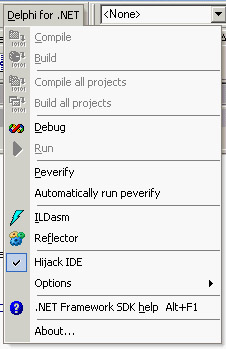
 |
|
Installing the Delphi for .NET PreviewThe Delphi for .NET Preview requires but does not install .NET Framework Runtime, which is freely downloadable from Microsoft's MSDN website. As a developer, you'll probably want to take an extra step and install the more complete .NET Framework SDK, which includes documentation and tools for developers (but is also much larger). You should install the .NET Framework Runtime or SDK before you install the Delphi for .NET Preview. The Preview compiler is compatible with the .NET Framework SDK and service pack 1. If you have applied service pack 2 or later, then you will have to perform the extra step of rebuilding the precompiled units (the dcuil files) installed with the Preview. This requirement might go away in subsequent updates to the Delphi for .NET Preview compiler.
After installing the .NET Framework SDK, insert the Delphi for .NET Preview CD and run the setup program. The Preview will install itself in a separate directory from your Delphi 7 installation, and none of your Delphi 7 settings are affected by installing the Preview. Previously I mentioned that you would need to rebuild the precompiled units shipped with the compiler, if you have installed service pack 2 for the .NET Framework. If this applies to you, open a command window and navigate to the source\rtl directory under the root of the compiler installation directory. There, you will find a file called rebuild.bat, which you must execute to perform the rebuild. You might see some errors and warnings; these are known issues at the time of this writing, and might be cleared up in subsequent updates to the compiler. Once the batch file has completed, you will be ready to go. The dccil compiler is located in the bin directory. Along with the compiler, in this directory is a file called dccil.cfg that specifies the default unit search path (the -U compiler switch), which is the units directory under the root installation directory. As packaged, the Delphi for .NET Preview compiler is strictly for use with a command window. However, Borland has made available an unsupported plug-in to the Delphi 7 IDE on the Borland Developers Network website, referred to as Delphi for .NET common line compiler IDE integration. Using the plug-in, you can control the dccil compiler from within the IDE, as you can see in the menu installed by this plug-in.  Note, however, that the plug-in does not give you the full capability of designing forms and all the other things Delphi is famous for. The Delphi for .NET Preview compiler is intended to give you some advance warning about new language features and a glimpse into how the Delphi run-time library might look in the .NET context. You can download this plug-in from the Code Central area of the Borland Developer Network website, bdn.borland.com (if you cannot find it, look under the number 18889). Another valuable resource you might want to work with is the Reflector. This tool was written by Lutz Roeder (who happens to work at Microsoft, by the way) and is available on his own website, www.aisto.com/roeder/dotnet.
Testing the InstallationNow it's time to test your Delphi for .NET Preview installation by compiling a simple console program that prints a message. You can start this project using Delphi 7, or you can type in the text with your favorite editor:
program HelloWorld;
{$APPTYPE CONSOLE}
uses
Borland.Delphi.SysUtils;
begin
WriteLn ('Hello, Delphi! - Today is ' +
DateToStr (Now));
end.
Notice how similar the code looks to the Delphi applications you're used to. The only difference is the uses clause. Borland has organized the units of the Delphi library into namespaces similar to those of the Common Language Runtime (CLR). I will discuss this in more detail in the next chapter. Save the file as HelloWorld.dpr and open a command window. Navigate to the location of the file and type dccil HelloWorld.dpr The result should be an executable image, HelloWorld.exe, which you can run from the command line to produce a single line of output. If you are using the IDE plug-in, compiling and running the program will involve pressing Ctrl+F9 or F9 after you've enabled IDE hijacking (see the Hijack IDE menu item in the screenshot above). If this program seems boring, you can begin your exploration of .NET using the windowed version of the hello world program instead of the console version. Called HelloWin, this program creates and shows a window on the screen, writing into its caption. It also shows the call to Application.Run, used to activate the application's message processing loop: program HelloWin; uses System.Windows.Forms, Borland.Delphi.SysUtils; var aForm: Form; begin aForm := Form.Create; aForm.Text := 'Hello Delphi'; Application.Run (aForm); end. In .NET presentations, the previous code raises the enthusiasm of programmers used to Microsoft development tools. As a Delphi programmer, you might have used almost this same code since 1995, so you might wonder where this excitement comes from. The output of these programs is far from interesting, but you can at least prove they are not classic Win32 applications by running ILDASM on them (directly from the plug-in's menu). You can see the output for the HelloWorld executable in Figure 24.1. Notice that the unit's global code is wrapped in a pseudo class called uUnit. Unlike Delphi, the .NET runtime doesn't account for global procedures and functions, but only class methods. But I'm getting ahead of myself; let's start from the beginning and look at the NET platform. |
|
||||||||||||||||||||||||||||||||||||||||||||||||||||||||||||||||||||||||||||||||||||||||||||||||||||||||||||||||||||||||||||||||||||||||||||||||||||||||||||||||||||||||||||||||||||||||||||||
| Copyright © 2004-2025 "Delphi Sources" by BrokenByte Software. Delphi Programming Guide |